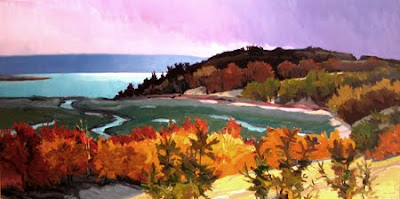Persistence v.s. The Spark of Invention

Philip Koch, Down to the Bay, oil on canvas, 36 x 72", 2008\
When problems resolve quickly, who isn't pleased? When resolution comes but only after a long process, one is pleased but that's laced with a bit of gratitude too. That's the story of this painting.
Begun in the late '90's the painting had a grey sky. It was, well, heavy looking. I tried all sorts of gymnastics with it but nothing really helped. So it went into my Banishment Room in the basement (described in my earlier post Hard Time in the Banishment Room). A year or two passed and I hauled the canvas up to the easel room and put in a violet sky similar to one of my favorite soft pastel chalk's color (you get attached to individual chalks to turn to them often). The sky, with its new coloration looked much better and I put in clouds in strategic spots. So, much improved, but I still felt it wasn't right, so back it went into Banishment.
I was sitting having coffee at the breakfast table one morning, thinking of something else, when Down to the Bay called out to me. It was out on a release for good behavior from Banishment Room and up on its end in my dining room to save space. Seeing a long horizontal composition turned vertical is a really good idea- it makes everything hit you in a different way. What I saw was the painting in that form had too many points of interest competing with each other. A large white cloud I'd previously placed behind the dark hill at the far right in particular was pulling way too much attention over to that side of the piece. I removed it, and the painting now focused happily on the oranges of the foreground against the violet hue of the open sky.
What went into making this story was a lot more weighted toward the persistence end of the scale. It took several major pushes just to get the piece ready for me to finally notice what would at long last pull it together. I much prefer the spark of invention to strike early in the process, but you might as well will the tides to stop. What counts I think is finding a good idea to work on and then staying with it through all its necessary stages until it finally blossoms.
My wife Alice likes to call me the most impatient person she knows (and she's not without grounds for making this accusation). But I've learned a working process for my studio that does an awfully good imitation of patience. It's how one prepares the kindling so the spark, when it finally decides to show up, has something to turn into flame.


